This small section – by no means exhaustive – aims at telling how animation cinema described the Moon, from its dawn down to the present day, through short films, are the form closest to poetry for its evocative and hermetic
structure. Since there are dozens of works, we thought of dividing them up according to more or less explanatory categories, even though we know that it is difficult to categorize, especially when these books can be read at different levels. A further criterion of choice has been the absence of words or dialogues to facilitate small children’s seeing and understanding.
Travel to the moon and flying cars
In the first category we have included the works related with the desire to reach the Moon, and explore it: scientists, acrobats and girls who build or use machines, rockets and other objects to reach our satellite. In this category, as in the other ones, there are films from the early years of the movies mixing techniques of shooting from life with step-by-step shots of animated cinema.
Even though they are not fully animated films, the plot of these stories is often developed on unnatural, two-dimensional backgrounds, reminiscent of puppet theaters, housing three-dimensional figures, often with a fixed camera and no changes of shot. The following selection is intended to be a journey into the films which have decribed the moon, sometimes long before man set foot on it, and a tribute to animated cinema starting from its origins.
About the availability of short films, manyof them are available online for free or for a fee, whereas the titles in 35mm copies or not available online but still viewable at the Fondazione Cineteca di Bologna are marked with an asterisk *
La Lune à un mètre (La Lune at 1 m distance)by George Mèliés (France / 1898, 3 ‘) An astronomer examines the Moon from his laboratory to discover its mysteries. With La Lune a un mètre George Mèliés anticipates one of his most famous films, Le Voyage dans la Lune, by 4 years. This film features the typical tricks of Méliès’s cinematography with continuous substitutions and appearances.
Le Voyage dans la Lune (Journey to the Moon) by George Mèliés, (France / 1902, 15 ‘) A cheerful group of scientists decides to build a rocket to explore the lunar soil but they come up with the selenites and run away. . .
The Motorist by Robert W. Paul (Great Britain / 1906, 2’36 ”) A couple driving their car to escape the police runs away into space and wanders among the planets.
Un matrimonio interplanetario (An Interplanetary Marriage)by Enrico Novelli (Italy / 1910, 15 ‘) Considered as the first sci-fi genre film in Italian cinema, it tells the adventures of an astronomer, Aldovino, who one night, while scanning the sky, falls in love with the beautiful Yala who lives on Mars. In order to conquer the loved one, he will have to build a spaceship.
The Flying House (Third episode of the series Dreams of the Rarebit Fiend) by Wilson McCay (USA / 1921, 12 ‘) The last animated film by Winsor McCay, born of the comic strip of the same name, describes the dream of escaping foreclosure of her home dreams of taking flight with her husband and using her home as a vehicle. A curiosity: in 2011 Bill Plympton retrieves the original McCay animation and makes it a 9 ‘color version without captions.
Felix the Cat – Astronomeous by Otto Messmer and Put Sullivan (USA / 1928, 6’50 ”) Felix the cat during an electoral rally launches into promises of space invasion, but once he reaches Saturn and Mars things do not work out the way he had hoped. We should recall that Felix the Cat was the star of animated films in the 1920s, thanks to his perspective tricks, and performances clearly inspired by Chaplin.
Cyrk * by Włodzimierz Haupe (The Circus, Poland / 1954, 15 ‘) * During a show, a circus performer accidentally lands on the moon. His friends sharpen their wits and build a rocket to go to his rescue. A fun journey to the Moon in puppet animation made at the Se-Ma-For Studio, one of the oldest animation studios in Europe.
Destination Magoo Pete Burness (USA / 1954, 6 ‘, 03’ ‘) Mr Magoo with his usual carelessness starts the rocket his friend is building to go to the Moon. What happens to our nice old man once he lands? And – above all – will it arrive on the moon?
Cico Pepe e l’allegra brigata Episodio Z15 * – Space pilot by Jan Karpas, Milos Makovec, Jirí Trnka (Italy-Czechoslovakia / 1959,10 ‘) * An episode of the series – “Cico Pepe and the Merry Brigade”, a film co-produced by Corona cinema and Ceskolovenski from the late 1950s . A little girl dreams of going into space and enjoys building a rocket, but is disturbed by a brat who gets up to all sorts of mischief.
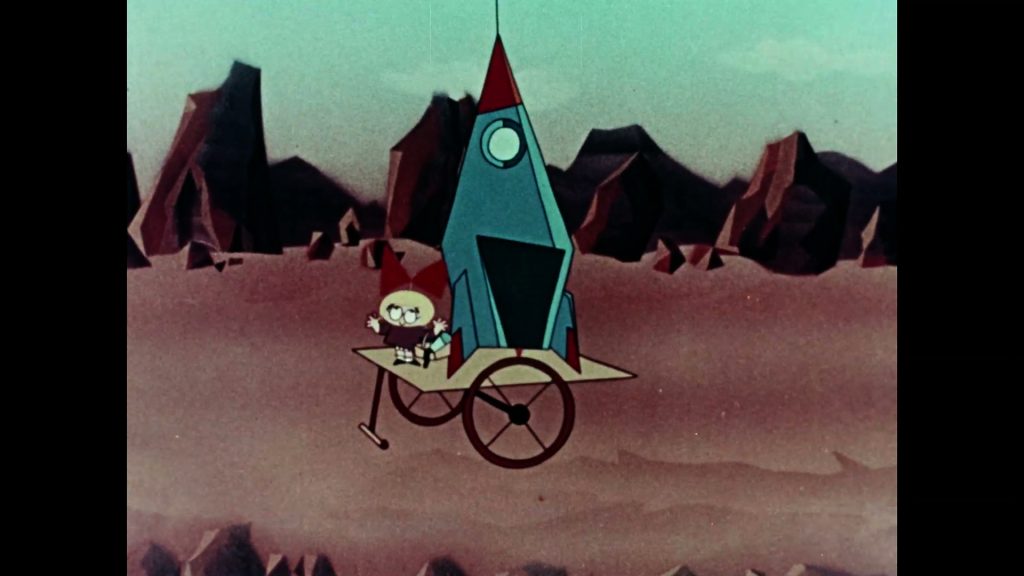
Woodpecker in the Moon by Alex Lovy (USA / 1959, 7 ‘) The character of the Woodpecker appeared for the first time in 1940 in the short film Knock Knock by Walter Lantz, and became famous starting from 1941 in the tv series which took its name, is an animation in Irving Pichel’s film Destination Moon (Men on the Moon) of 1950, in order to describe the problems related to space rocketry, as well as the physical and technical difficulties which astronauts should take into account for a possible trip to the Moon. Practically, this is little manuel of space engineering.
Houzi lao yue (Monkey Fishes the Moon) by Keqin Zhou (China-France / 1980, 11 ‘) In a forest a group of monkeys discover the Moon and, fascinated by it, try in every way to capture it.
A Grand Day Out (Wallace and Gromit – A fantastic trip, by Nick Park (Great Britain / 1989, 24 ‘) The adventurous journey to the Moon of the famous couple by Aardman Wallace and Gromit in search of one of the foods they are most fond of : cheese Awarded with a BAFTA and Academy Awards nomination.
Les aventures de Tintin. On a marché sur la Lune (The Adventures of Tintin. Men on the Moon I and II by Stéphane Bernasconi, Philippe Condroyer, Jean Jacques Vierne (France / 1991, 24 ‘+ 24’) In the two episodes which make up The Adventures of Tintin. Men on the moon, the young reporter and protagonist of many adventures – born from the pen of Hergé – is involved in an international plot, aiming at stealing the plans of prof Girasole. After a journey full of unexpected events, Tintin and his companions finally land on our satellite, but a series of accidents will jeopardize the mission and the lives of our astronauts. Will they all be able to return safely to Earth?

Little Wolf by An Vrombaut (Great Britain / 1992.6 ‘) A group of wolves chases a sheep when one of them, attracted by the Moon, goes away. Once reached the beloved satellite, he does not know how to get off, thus his friends do their utmost to help him.
One Small Step by Andrew Chesworth and Bobby Pontillas (CinaUSA / 2018, 8 ‘) “That’s one small step for [a] man, one giant leap for mankind”, the famous phrase by Armstrong, gives the title to this beautiful short film by TAIKO Studios, which tells us the dream of a little girl who – with passion, work and determination – tries to go to the moon.
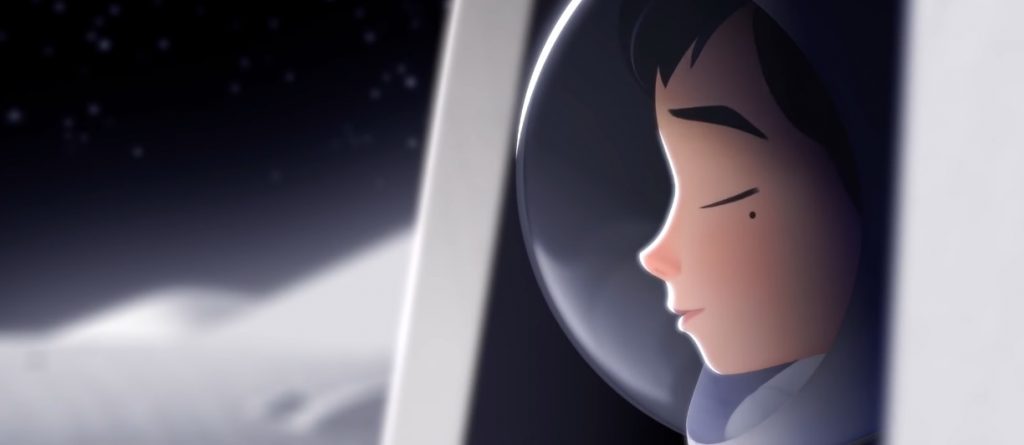
How wonderfully the moon shines today
How wonderfully the Moon shines today – the title of a film by Vladimir Dudkin, is also the section where you look at the Moon with a romantic and dreamy gaze, as a place to take refuge, a backdrop for nights of love, and a child dream. The Moon enchants painters, musicians and directors.
By The Light Of The Silvery Moon by Dave Fleischer (USA / 1931, 6’42 ”) Written in 1909 by Gus Edwards and Edward Madden By The Light Of The Silvery Moon is a popular song that Dave Fleischer, father of characters such as Koko the Clown and Popeye, he decided to adapt to the big screen in 1931 with a small appearance of his character Betty Boop. In 1953 the song was brought back to the big screen in a musical with Doris Day
Ups and Downs – Betty Boop by Dave Fleischer (USA / 1932, 7 ‘) The beautiful Betty Boop is forced to leave her broken home, but the planet also suffers that tragic fate. At an interplanetary auction managed by the Moon, Saturn buys the Earth, but the new owner causes some confusion.
Dancing on the Moon by Max and Dave Fleischer (USA / 1935, 8 ‘) The episode of the Color Classics series, tells of an organized trip to the Moon for just married couples. Unfortunately, a bride remains on the ground and … The Color Classics are a series of cartoons with a complex stereoscopic process invented by the Fleischers. The technique uses three-dimensional models of backgrounds, so as to give a sense of depth to the work, anticipating Disney’s multiplanes.
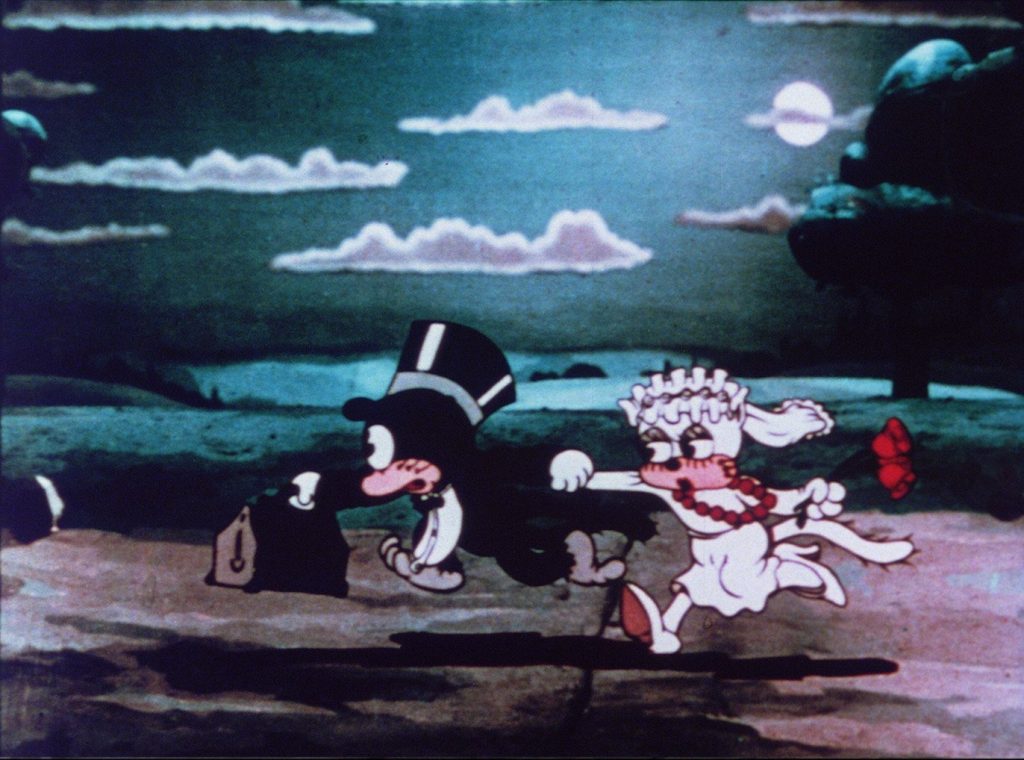
Clair De Lune by Sam Armstrong (USA / 1940, 6’38 ”) Deleted sequences from the 1940 collective film Fantasia produced by Walt Disney. Against the backdrop of a picturesque nocturnal swamp lit only by the moonlight, a stylized heron moves to the music of the famous piece by Debussy. Only in 1946, with the release of Musica Maestro, did they decide to recycle the material relating to Clair de Lune, completely distorting it. The animation was not altered in any way, but Debussy’s music was removed and replaced with the contemporary popular song Blue Bayou.
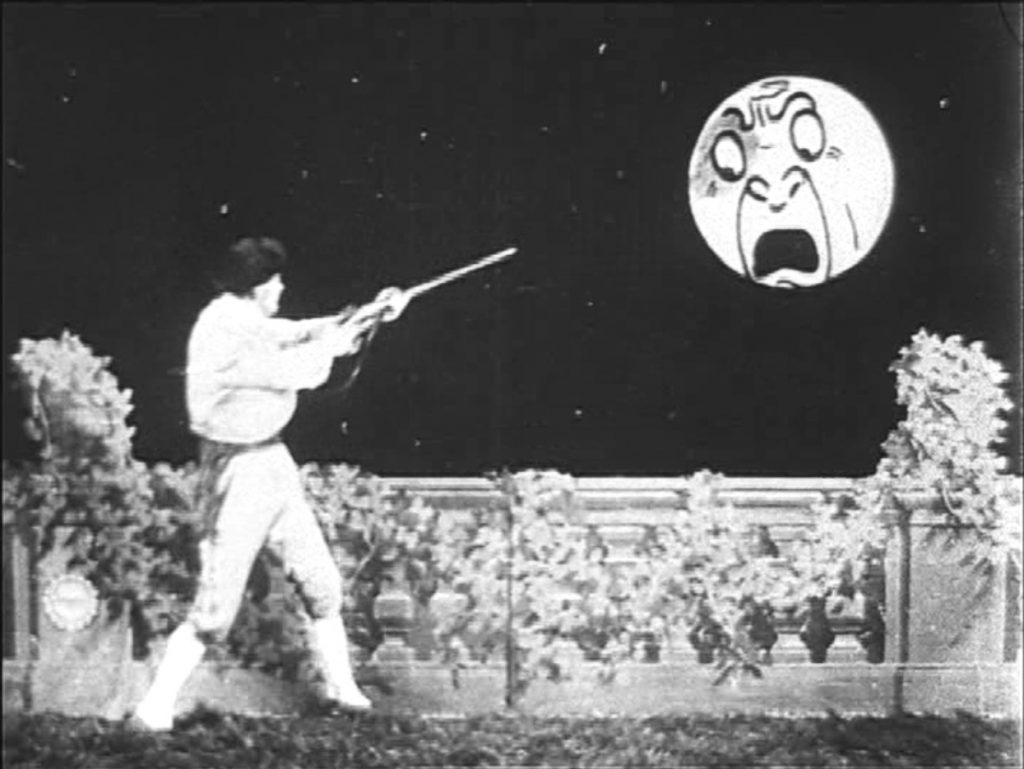
Dregen Og Månen * by Jannik Hastrup (Denmark / 1968, 7’30 ”) * In the middle of the nigh,t a child observes the Moon from his room but a strange character appears to enliven his evening. A film in which scraps of paper move to a jazz rhythm.
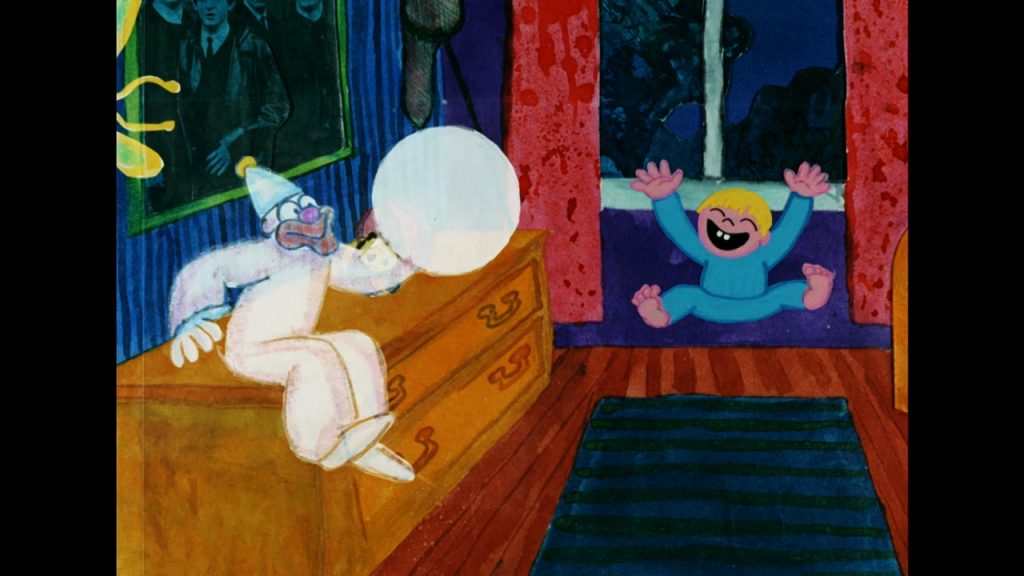
How bright the Moon is today * by Vladimir Dudkin (USSR / 1988, 10 ‘) * The animals of the wood gather to admire the extraordinary splendor of the Moon. The bear, irritated by the romantic speeches of hares and frogs, does everything to ruin their evening, but without success.
Le Petit Garçon qui vole la Lune (The Boy who stole the Moon) of Ernest and Gisèle Ansorge (Switzerland / 1988, 7 ‘) A child kidnapped by the beauty of the Moon manages to catch it and bring it to Earth, however the disappearance of the satellite worries and provokes confusion among the inhabitants of the forest. Freely based on the book with the same name by Charles-François Landry, the short film is made with the sand animation technique, of which the Ansorge were great masters.
Estória do gato e da Lua by Pedro Serrazina (Portugal / 1995, 5’30 ”) The narrative voice of Joaquim de Almeida and the music of Tentúgal evoke a passionate obsession of a cat who, bewitched, ceaselessly searches for the luminous, attractive spectrum of the beloved Moon. The story of the cat and the moon plays freely with a series of visually strong transitions, juxtapositions and contrasts, between light, shadow, curves and diagonal, suggesting a story of a white moon and a black cat which, after all – symbolically – can also be white.
Moon Man by Paul Morstad (Canada / 2004, 3’05 ”) The short film Moon Man is inspired by the song Moon Man Newfie, composed and sung by the Canadian music legend Stompin ‘Tom Connors is the second animated film by the NFB which uses the revolutionary IMAX SANDDE digital system, which allows animators to draw and animate 3D images in space with a movable wand. •
Mondspaziergang by Jutta Schünemann (Germany / 2004, 4’48 ‘) A child walks with his dog and is fascinated by the Moon, reaches it with a ladder, but it gets out of hand. An animation in pastel tones that makes children dream and enchants them.
Wollmond by Gil Alkabetz (Germany / 2009, 6 ‘) An old lady spends her time in the company of a cat, knitting a sweater for the Moon. However, the alternation of the Moon phases, in the course of a month, complicate things.
La Luna by Enrico Casarosa (USA / 2011, 7 ‘) The Pixar short film screened before the film The Brave (Rebel) tells of a child who is carried by his grandfather and his father on board a small boat to the moon. Their job is a bit special, since they take care of the maintenance of our beloved satellite. A majestic and brilliant Moon is the setting for a film on autonomy.
Every Star by Yawen Zheng (USA / 2014, 4 ‘) The very young Yawen Zheng, already selected in Annecy, one of the main European animation festivals, with the beautiful short film The Song For Rain tells the story of the child of the stars who, on Moonlit nights , collects stars for the city children who, due to the cloudy sky, cannot see them.
La Petite étoile by Svetlana Andrianova (Russia / 2015, 6 ‘) Two promising stars of Russian animation, Svetlana Andrianova directing and Yulia Aronova creating the scenarios with paper cutouts, tell the story of mother Moon and the little stars of which he takes care of. One day, however, a star falls on Earth and mother Moon will have to rush to bring her home. * Copy in 35mm or not available online, viewable at the Cineteca di Bologna Foundation.
we also recommend:
the doodle Back to the Moon – In honor of Georges Méliès a collaboration with Google Spotlight Stories, Google Arts & Culture and Cinémathèque Française (USA-France / 2018, 2’10 ”)
the series
Futurama Matt Groening (USA / 1999-2003)
Space: 1999 (Space 1999) Gerry and Sylvia Anderson (Italy-Great Britain / 1975-1979) •
Sailor Moon (Japan / 2003-2004)
feature films
The shining princess (Kaguya-hime no monogatari) by Isao Takahata (Japan / 2013)
Hugo Cabret by Martin Scorsese (USA / 2011)
Mune, le gardien de la Lune (Mune the Guardian of the Moon) by Alexandre Heboyan and Benoît Philippon (France / 2014)
Jean de la Lune by Stephan Schesch (GermanyFrance-Ireland / 2012)
Despicable Me (Despicable Me) by Chris Renaud and Pierre Coffin (USA / 2010)
Paper Moon by Peter Bogdanovich (USA / 1973)
